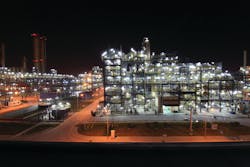Dow, Air Liquide and Chevron were early adopters of virtual reality (VR) as a training tool.
Now they are leveraging it to further improve training, both in their process and business activities, by working closely with specialist vendors and start-ups.
For example, Dow, based in Midland, Michigan, is establishing several innovation centers around the world. The first, at the company’s Zhangjiagang site in China, focuses on environment, health, safety and sustainability functions.
One of the main challenges with traditional safety training programs is an over-reliance on non-interactive tools, such as video and slides, that don’t involve critical and quick-thinking skills, Dow noted in a March 8 news release.
“The available learning technology has created challenges in ensuring understanding of the nuances between existing safety and sustainability standards and the guidelines governing them when issues play out in real life,” the company said.
So, the plan at Zhangjiagang is to use VR technologies to close these gaps and decrease risks.
In a similar vein, Paris-based Air Liquide has opened a smart innovative operations (SIO) center in Kuala Lumpur, Malaysia, to accelerate troubleshooting, improve local operations and give access to expertise across borders. The center leverages a range of digital tools, including some developed with start-ups.
VR-based immersive training is a cornerstone of the SIO’s efforts. Air Liquide believes that exposing employees to real-time training in a simulated environment that mimics the layout and operations of an actual plant is a vast improvement on traditional theoretical studies.Additionally, this training method improves employees’ technical understanding of on-site operations without incurring the typical cost of an on-site training program — or training-related injuries, the company notes. The approach is particularly helpful in improving productivity in complex environments, such as air-separation units, according to the company.
“Since VR has advanced to a stage where it is able to produce a virtual replica of the plant operations, employees can train as many times needed — generating a pool of highly skilled employees,” notes the company.
Other Digital Efforts
Chevron also has begun working to improve its digital capabilities.
In May, Motive.io announced Chevron had selected the company as part of the Chevron Technology Ventures Catalyst program. A long-standing and early adopter of immersive technologies, Chevron uses the program to identify new technologies with the potential to enhance its process and business activities. Its latest investment round involves US$90 million.
Motive.io designed its XR management system (XMS) to help users create, edit and deploy VR training modules faster. The system’s authoring tool allows users to create and edit VR training without having to write code and integrates with a customer’s own learning management system (LMS). This works with both the Sharable Content Object Reference Model and xAPI software packages out of the box, with no changes needed. The platform also includes a conversational AI component.
“I am very bullish on AI in general; however, it's hard to say at this stage exactly how and where it will impact immersive technology,” says Motive.io CEO Ryan Chapman.
One possibility is the use of fully conversant digital agents to enhance training. “Training scenarios often benefit from the ability for the learner to ask a professional for guidance if they are unsure of what step to do next,” he explains. “An AI-powered agent could fill the role of an adviser if a real trainer isn't available.”
AI may also be useful in the development of 3D scene and asset generation, as well as training simulation scenarios.
The use of VR and other immersive training technologies grew steadily during the pandemic as companies sought new ways to train and engage their remote workforce, Chapman says.
That said, he notes that use and deployment challenges remain. “A negative first experience with a poorly designed application can turn off many users,” he cautions. Also, the cost to create and manage the content can quickly become prohibitive.
“The best deployments we've seen focus first and foremost on the business problem that the training is solving,” Chapman says. “These have a much better track record because they can demonstrate a very clear ROI to the stakeholders and the ultimate decision-makers.”
C-level sponsorship is another critical component of a successful VR training program, notes Luca Vezzadini, co-founder and CTO of software company Kairos3D. He also suggests that chemical companies considering VR technology take time to identify their specific training needs and consider whether they want to prioritize a learning program for onboarding newcomers for high-risk activities, emergency response protocols or equipment handling.
“Also, the involvement of subject matter experts is always critical for the creation of effective training simulations,” Vezzadini adds.
Kairos3D, which counts several petrochemical companies as customers, specializes in creating 3D digital twins, with a focus on training process industry field operators.“Such experiential, simulation-based learning is the most effective way to give the workforce the situational awareness needed to make the right choice in every scenario,” Vezzadini says.
One scenario involves integrating its 3D technology with training programs based on LMS. Here, trainees initially engage in conventional theoretical online lessons, and once they successfully complete this part, they gain access to the company’s immersive 3D modules. Within this environment, they encounter increasingly complex scenarios and must achieve a minimum score for each scenario to advance.
“Not only does this approach support the learning process for newcomers, but it also provides value for seasoned operators who need to review rarely used procedures, acquire novel practices or gain proficiency in specific emergency situations,” notes Vezzadini.
This methodology allows quantitative analysis of users, such as scoring and facilitates the monitoring of workers’ readiness for the wide range of operations they will be required to perform in the real world.
“In fact, asset managers and HR managers are supported in their decisions from the system's automated dashboards, which provide insights into the theoretical and practical preparedness of operators across various procedures and practices they must execute in the field,” he explains.
A second common application involves integrating the 3D platform with traditional operator training simulators (OTS). These dynamic process simulation tools address the learning needs of board operators.
Using an agnostic interoperability layer that allows bi-directional integration with the OTS, trainees can then maneuver the equipment in the 3D model and experience the simulated reaction of the 3D virtual representation of the plant according to the values computed by the OTS process model.
The 3D-OTS integrated training system can be used with the assistance of an instructor or in unattended mode.
A third common application involves projects where VR simulations are used in standalone mode, neither connected to OTS/process models nor integrated with LMS. Here, trainees select the scenario they want to exercise and are then driven by the system to familiarize themselves with and execute the tasks that build up each training procedure.
“This translates to a risk-free, cost-effective approach to train field operators for what awaits them in the real world through experiential learning. Major benefits include a significant reduction of logistic costs, a higher knowledge transfer without pulling SMEs away from their work and a safer, more effective performance of industrial facilities,” notes Vezzadini.
Is VR Really the Answer?
Questions remain as to VR’s future within the chemical industry. It could be a solution looking for a problem, cautions Dave Strobhar, chief human factors engineer at Beville Operator Performance Specialists.
“The attitude in the industry seems to be ‘This is great. Now how can I use it?’” he says. But Strobhar believes that, without proper training objectives, VR technologies run the risk of mirroring the early evolution of simulators in the process industry.
“I don’t think there’s enough honesty about what happened,” he reflects, pointing out that while everyone was keen to buy them up when they first came out, many ended up in back rooms covered in dust or cannibalized for spare parts.
“The senior management of one company I worked with thought it was a great idea to put their simulator in the control room and that the operators would simply go over and do something with it if and when they got a chance. There was no thought put into how they were ever going to use the simulator — and they never came with any training curriculums from the vendors in those days, either,” Strobhar adds.
While that situation has improved, with learning plans and objectives much more defined now, his experience is that training departments often still don’t realize they have a problem in the first place.
For example, he cites a Center for Operator Performance project, which looked at training programs carried out by different refineries. One took a week to get an operator onto the unit, another took eight weeks. Both were happy they were turning out operators as good as they could be. “So everybody thought they were doing a good job. Obviously, there’s something wrong here,” he suggests.
Even stranger, when an operator moved from one refinery to another — within the same company — he failed the training program at the second despite being fully qualified at the first. “Something’s surely amiss in all of this,” he says.
He wonders, would VR technology be used effectively in this situation or any other where the training departments don’t fully understand their own challenges?
On the other hand, Strobhar notes that the ability of VR technologies to allow field operators to practice something they couldn’t do on a live plant, such as starting up a compressor, would have benefits. Those gains could be even more significant if VR could mimic the sort of muscle memory involved in changing a particular piece of equipment, such as a pump.
However, he believes the best experience is always gained by being out in the plant.
“The point is not to spend extra money where you don’t have to,” he says. “If it’s just walking around a unit, with full access to a facility, I can do the same thing without any snazzy VR technology.”





